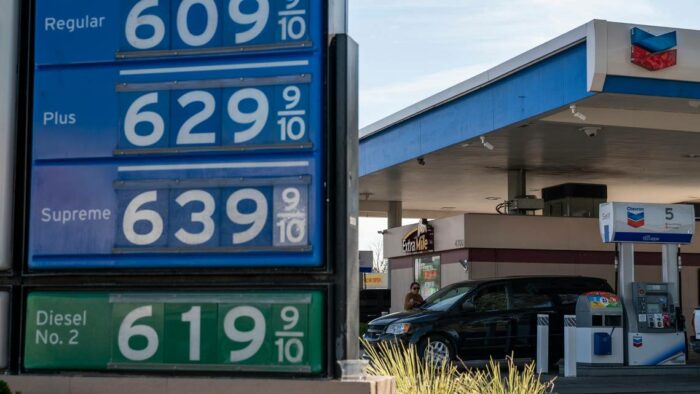As gas prices soar, Gov. Newsom could save California drivers $1 billion
Link to article: https://stillwaterassociates.com/as-gas-prices-soar-gov-newsom-could-save-california-drivers-1-billion/
September 29, 2022
Update: On September 30, 2022, at the direction of Gov. Newsom, the California Air Resources Board (CARB) issued a regulatory advisory allowing the sale or supply of gasoline in California that exceeds the Reid Vapor Pressure (RVP) limits in CARB’s gasoline regulations, from September 30 through October 2022.
When gas prices spike in California, Stillwater’s phones start ringing. Reporters and consumers alike want to know what’s causing the price increase and what can be done about it. So it was when the spot market in California took off this week, reaching historic levels in the Bay and LA. NBC7 San Diego and The San-Diego Union Tribune have run stories with brief insights from Stillwater’s Chairman Dave Hackett this week, but there’s more to the story:
What’s causing the rise in prices?
- The Pandemic: COVID-19 is everyone’s favorite scapegoat, but it’s true that the pandemic effect is at play here. When Covid struck, the economy shut down, and lockdowns were implemented, petroleum demand and refiner profitability both cratered. Some refineries, like Marathon Martinez, shut down and aren’t restarting. At other refineries, maintenance budgets were slashed, and people were let go, some never to return. Which brings us to our next point…
- Refinery Turn-Arounds: By the winter of 2021, it looked like Covid was “over” and profitability was returning, so plans were made to begin refinery maintenance (turn-arounds) beginning in the Spring of 2022. Then Russia invaded Ukraine, and maintenance was deferred again. Now, in the Fall of 2022, the refining fleet is limping badly, resulting in a production shortfall. Several refineries in California and Washington are now undergoing both planned and unplanned maintenance. Further complicating the maintenance situation, is the fact that refinery turn-arounds often require hundreds of workers for a month or two. This workforce mobilization was nearly impossible during COVID and continues to be challenging given the current labor shortage.
- State Climate Change Initiatives: California’s greenhouse gas reduction policies incentivize low-carbon fuels over petroleum-based fuels, limiting the future useful life of refineries. As such, the refinery maintenance philosophy has shifted toward short term rather than long term. (i.e., How much you are willing to pay for repairs depends on how long you will keep the item.) This policy environment has contributed to the decline in refinery productivity in California. The effect is exacerbated by the fact that California’s unique blend of gasoline (CARBOB) is normally only produced by just ten refineries, all of which are on the West Coast.
- Short is the New Norm: California refineries can’t keep up with the state’s gasoline demand, and the Washington refineries that normally supply California can’t either. We are now six weeks away from imports from Korea, India, or Europe. With unplanned outages, especially during periods of low inventory, reliance on imports exposes California to price spikes. This problem will only get worse until the West Coast is net long again.
- Low Inventory & High Demand: Put simply, gasoline prices are at record high levels due to supply and demand fundamentals. The region currently has the lowest stock levels in a decade at a time when drivers are wanting to hit the road after Covid lockdowns.
What can be done to bring down prices?
The solution to the current supply crises, and very high retail prices, is to find increased supply of gasoline. This will occur naturally on November 1st when the California market switches to the winter blend, which increases the volume of gasoline that refiners can make by increasing the allowable volatility (i.e., Reid vapor pressure or RVP) of the product. Spot prices in November are now $2.00/gallon less than the current spot price. As such, Governor Newsom has one prompt policy lever at his disposal: He could authorize California’s winter blend of gasoline this week, a month ahead of schedule.
Gasoline prices will remain relatively high until the larger maintenance and supply issues are ironed out over the next few weeks. Early approval of winter blend will increase gasoline supply by 5-10% and should immediately reduce the currently sky-high spot price by at least $1/gallon. Since California gasoline demand is about a billion gallons per month, this action would save California consumers about a billion dollars in October. Gas prices are likely to soar to $6.50 or even $7.00 per gallon in the short term until winter volatility is authorized.
It is worth noting that there is historic precedence for this authorization; Governor Schwarzenegger took this approach in 2005 during Hurricane Katrina and Governor Brown did the same in 2012 when the Torrance refinery experienced an outage.
Stillwater sees things others miss! Want to talk about how our expertise and insights could support your business? Contact us.
Tags: California, fuel prices, gas prices, Maintenance, RVP, supply and demand, West Coast BalancesCategories: Economics, News, Policy, Wisdom from the Downstream Wizard

